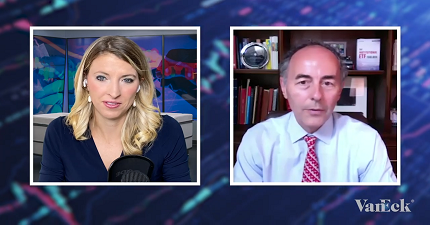Growth Prospects in Emerging Markets Heading into 2018
29 novembre 2017
Temps de Visionnage 08:59
Growth Prospects in Emerging Markets Heading into 2018
Edited for Clarity
TOM BUTCHER: Emerging markets economies continue to thrive. I’m here today with Natalia Gurushina, Chief Economist for emerging markets at VanEck. Natalia, thanks so much for joining me. What’s your outlook for growth in the emerging markets?
NATALIA GURUSHINA: The emerging markets growth momentum has improved markedly in the past year and a half, recouping most of the losses it suffered after the taper tantrum. And the scope of growth actually broadened beyond the usual suspects such as Russia and Brazil. We also see several tailwinds, many of them cyclical, that we think should support young growth in the coming months. High commodity prices is one factor. The improved credit impulse in emerging markets is another one worth mentioning. In many emerging markets we also see strong investment growth and still very sizeable policy cushions. Developments like broader growth in developed markets and the recovery in global trade, despite all the concerns about NAFTA negotiations, should also help. As regards broader growth in developed markets, if you look at the latest PMIs [Purchasing Managers’ Indices] in the Eurozone, they look very encouraging. This includes very strong forward-looking components. In the United States the economy is still at the later stage of the business cycle, but it is not deteriorating. The prospect of tax reform and corporate tax cuts should improve sentiment, which is already positive – as we can see in multiple surveys, hopefully creating a positive feedback loop for growth. There is a concern, a legitimate concern, about the quality of growth in some emerging markets, Turkey and South Africa, to name just a few. But I also would like to say that many emerging markets have redeemed themselves policy-wise in the past couple of years, hopefully creating a better and stronger growth foundation going forward.
BUTCHER: How do you view the prospect for growth in the context of quantitative easing and the central banks reducing their balance sheets?
GURUSHINA: The policy bias in major central banks became more hawkish lately. We think that emerging markets can potentially be affected through a number of channels. Channel number one is higher funding costs and a lower potential for policy easing (local policy easing) in emerging markets. I don’t think that all emerging markets will be affected uniformly. There is a group of countries, which includes Turkey and South Africa, and probably Mexico to a certain extent, that failed to use an opportunity that they had when interest rates were very low to strengthen their balance sheets and to introduce additional structural reforms. We think that this group of countries probably would be affected the most. For example, in the case of Mexico, it is not a far reaching conclusion to expect the central bank to mirror the Fed [U.S. Federal Reserve] hike, even though there are signs of disinflation in the economy. By contrast, there are countries like Russia, Brazil, and Indonesia which were pretty much forced to adjust when commodity prices were low. So these countries are in a much better spot right now. I can, for example, easily see a scenario under which a central bank in Russia will continue with the rate cuts, despite a tighter monetary policy in the United States. That is channel number one.
Channel number two, through which emerging markets growth can be affected, is smaller capital inflows. If you look at the sequencing of policy steps in major central banks, it looks like the Fed will be moving a little bit more aggressively in the next few months than the ECB [European Central Bank], which signals that probably there will be some appreciation pressure on the U.S. dollar: typically, a stronger dollar is associated with smaller portfolio inflows between emerging markets. Once again there is a group of countries, which includes Turkey, South Africa, and Mexico (I would probably mention Chile and Colombia among them), which has relied very heavily on portfolio investment in the past years and probably not payed as much attention to strengthening local credit fundamentals. These countries seem to be particularly exposed to this type of risk.
Finally, the last channel which I think is relevant in the context of policy withdrawal globally is China’s deleveraging. (We are not talking about it too much in this context. But I think it is important.) What we expect is that Chinese authorities will continue to impose tighter credit and environmental restrictions, and probably will continue implementing some supply side reforms. If this is the case, then growth in commodity exporters in emerging markets is likely to be affected, but probably not as much as in the previous episode between 2012 and 2015.
BUTCHER: You have mentioned a lot of countries. Which are your favorites and why?
GURUSHINA: The countries that we like under the current circumstances are those countries which are early, or relatively early, in their business cycle: countries that have a reasonable policy cushion, that introduce structural reforms and pursue orthodox monetary and fiscal policies. Also countries which have high interest rates, or real interest rates in the case of local debt, relative to their fundamentals. A lot of conditions, but countries that fit this definition are Russia, Argentina, Brazil, and also smaller countries like Mongolia and Ecuador for example. Argentina’s case is really quite amazing because the country has been introducing a lot of structural changes lately. President Macri’s spectacular success during the midterm elections tells us that the chances of successfully implementing them are quite high because the mandate that he received is very strong.
BUTCHER: Can you just give me one comment on what you think about all the talk of synchronization amongst economies around the world?
GURUSHINA: There are some signs of synchronization. But if you start looking closely at where the economies are in the business cycle, the U.S. economy is, globally, a bit further ahead. It can be sustained given the right policies, especially with regards to the tax reform and tax cuts. The ECB is following the U.S., probably two or three quarters behind. But I think the country that really started to emerge in the developed world is Japan. So I would say in terms of synchronization: “Yes.” Global growth seems to be moving up, but it looks like different countries, at least in the developed world, are in slightly different parts of the cycle. So: “Yes” and “No.
BUTCHER: Okay. Natalia, thank you very much indeed. Should you wish to learn more about emerging markets, natural resources, gold or municipal bonds, please visit VanEck’s website at www.vaneck.com. And while you’re there, do take the opportunity to sign up to any of its subscriptions to email and insights that are on offer.
Related Insights
Related Insights
13 décembre 2024
13 août 2024
06 août 2024
01 mai 2024
13 août 2024
09 septembre 2021
08 mars 2021
27 novembre 2020








